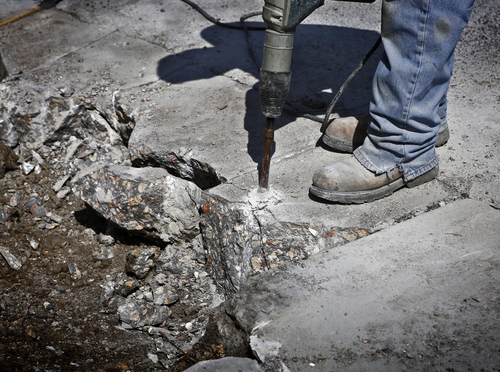April 25, 2024 - Benjamin Ehinger
How to Break Concrete: A Step-by-Step Guide for Efficient Demolition
CALL NOW 844-762-8449
Breaking up concrete can seem like a daunting task, but with the right approach and tools, it can be carried out efficiently and safely. Whether you’re looking to remove an old concrete slab or just want to make space for a new project, understanding the proper techniques and preparations is crucial. Before you start, it’s important to assess the size and thickness of the concrete, as this will determine the type of tools and methods you’ll need to use. Securing the work area should be your first priority to prevent any accidental damage to surrounding property.
Safety always comes first when dealing with heavy materials and powerful tools. Make sure you’re equipped with the necessary safety gear like gloves, goggles, ear protection, and sturdy boots. Selecting the appropriate tools, such as a sledgehammer, jackhammer, or chisel, can make the job easier. When it’s time to dispose of the broken concrete, consider getting a concrete dumpster rental from Waste Removal USA to manage the waste effectively.
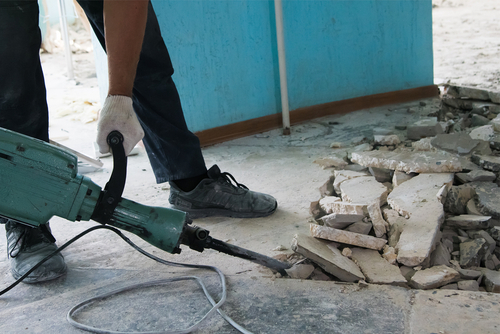 When you’re faced with a concrete demolition project, the selection of tools determines your efficiency and effectiveness. There are both manual and power tools that can aid in breaking up concrete, and your choice will depend on the scope and scale of your project.
When you’re faced with a concrete demolition project, the selection of tools determines your efficiency and effectiveness. There are both manual and power tools that can aid in breaking up concrete, and your choice will depend on the scope and scale of your project.
Remember to adhere to safety guidelines when operating any demolition tools, such as wearing appropriate eye and ear protection, gloves, and dust masks. Use ear defenders when operating loud equipment like jackhammers and always follow the manufacturer’s instructions for safe operation.
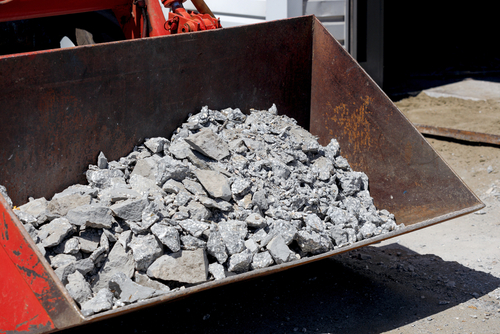 Breaking up concrete often involves dealing with reinforcements such as rebar and wire mesh. These materials strengthen concrete and can pose a challenge during demolition. You’ll need specific tools and techniques to handle them effectively.
Breaking up concrete often involves dealing with reinforcements such as rebar and wire mesh. These materials strengthen concrete and can pose a challenge during demolition. You’ll need specific tools and techniques to handle them effectively.
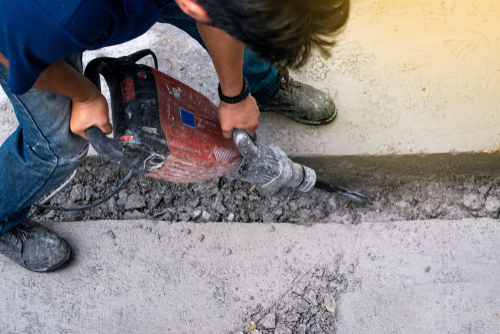 Before attempting the physical task of breaking up concrete, you need to understand the pivotal role of digging and undermining. These methods facilitate easier removal of concrete and minimize exertion.
Before attempting the physical task of breaking up concrete, you need to understand the pivotal role of digging and undermining. These methods facilitate easier removal of concrete and minimize exertion.
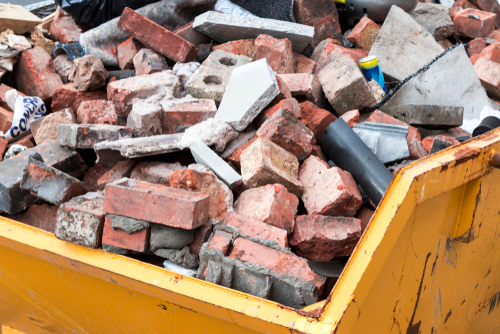 After you’ve successfully broken up the concrete, your next steps involve the proper handling of debris and safe disposal methods. It is essential to know the most efficient ways to gather the concrete pieces and where to responsibly dispose of them.
After you’ve successfully broken up the concrete, your next steps involve the proper handling of debris and safe disposal methods. It is essential to know the most efficient ways to gather the concrete pieces and where to responsibly dispose of them.
Key Takeaways
- Concrete breaking requires assessment of concrete thickness and securing the work area.
- Personal safety gear is imperative to protect against injury during concrete demolition.
- After breaking concrete, efficient disposal via a concrete dumpster rental is recommended.
Preparing the Work Area
Before you begin the process of breaking concrete, it’s imperative to properly prepare the work area. This will ensure your safety and the efficiency of the task at hand.Marking the Concrete
Firstly, you need to mark the area of concrete you plan to break. Use chalk or spray paint to draw clear, precise lines around the sections you’ll remove. This step helps you stay focused on targeted areas and avoid unnecessary damage to surrounding surfaces.Setting Up Protection
For protection, start by laying down plastic sheeting around the work zone. This will help contain debris and make cleanup easier. Ensure you’re wearing the correct safety gear, including goggles, gloves, dust mask, and ear protection, to safeguard against flying fragments and dust. It’s crucial to secure or remove any surrounding items that might obstruct your movement or could get damaged during the work.Safety Measures and Gear
Before you begin working with concrete, it’s crucial to prioritize your safety. Adequate gear will protect you from common hazards such as debris and dust.Wearing the Right Equipment
Your personal protective equipment (PPE) should include:- Safety Goggles or Face Shield: Protect your eyes from flying concrete chips. Choose safety goggles that have side shields for comprehensive eye protection.
- Hard Hat: Wear a hard hat at all times to prevent head injuries from falling debris or accidents.
- Dust Mask or Respirator: Concrete dust can be harmful if inhaled; use a dust mask for short tasks or a respirator for extended periods or when there’s significant dust.
Dust Management
Managing concrete dust is not only about your health but also about maintaining visibility and reducing clean-up time. Here’s how you can keep dust under control:- Use a wet cutting method when possible, as water helps to suppress dust.
- For dry cutting, drilling, or breaking, ensure that your equipment is attached to a dust extraction system appropriate for concrete dust.
Choosing the Right Tools
 When you’re faced with a concrete demolition project, the selection of tools determines your efficiency and effectiveness. There are both manual and power tools that can aid in breaking up concrete, and your choice will depend on the scope and scale of your project.
When you’re faced with a concrete demolition project, the selection of tools determines your efficiency and effectiveness. There are both manual and power tools that can aid in breaking up concrete, and your choice will depend on the scope and scale of your project.
Manual Tools
For smaller projects or precise demolition work, manual tools may be your go-to. A sledgehammer is suitable for concrete slabs less than three inches thick. To use, stand with your feet shoulder-width apart for stability and swing with controlled force, aiming 6 inches from the edge of the slab. To lever up broken pieces, employ a sturdy chisel and pry bar combination. When prying, always ensure you have a firm footing and leverage from a solid base to avoid injury.- Sledgehammer: Best for thin slabs
- Chisel and Pry Bar: Useful for lifting and removing debris
Power Tools Selection
Larger jobs require more powerful tools to save time and reduce physical strain. A jackhammer is the most iconic and powerful tool for breaking through hard concrete. However, a hammer drill fitted with a chisel bit can also be effective for drilling holes in concrete to weaken its structure or for smaller demolition tasks. For cutting concrete, consider an angle grinder or a power saw equipped with a concrete blade. These offer precision and the ability to cut reinforcing steel if necessary. Power Tool Guide:| Tool | Use |
|---|---|
| Jackhammer | Breaking thick slabs of concrete |
| Hammer Drill | Drilling holes, light demolition |
| Angle Grinder | Cutting concrete, precision work |
Techniques for Breaking Concrete
When you need to break up concrete, the right tools and techniques are crucial for efficiency and safety. Power tools will save you time and effort, and understanding how to apply pressure correctly will minimize strain and maximize impact.Breaking with Sledgehammer
To break concrete into chunks, a sledgehammer is often your first go-to solution. It requires manual effort, but it’s effective for smaller projects. You’ll want to:- Identify the breaking point: Start near an edge or a corner.
- Strike effectively: Swing the sledgehammer overhead and apply pressure firmly to create cracks.
Using a Jackhammer
If you’re facing a larger area or thicker slabs, a jackhammer is the power tool needed for the task. Here’s how to use it:- Safety first: Always wear protective gear including ear protection, gloves, and safety glasses.
- Position the tool: Place the jackhammer on the concrete where you want to break it.
- Operate with control: Engage the jackhammer with steady pressure, letting the tool do the work to break concrete into manageable chunks.
Removing Reinforcements
 Breaking up concrete often involves dealing with reinforcements such as rebar and wire mesh. These materials strengthen concrete and can pose a challenge during demolition. You’ll need specific tools and techniques to handle them effectively.
Breaking up concrete often involves dealing with reinforcements such as rebar and wire mesh. These materials strengthen concrete and can pose a challenge during demolition. You’ll need specific tools and techniques to handle them effectively.
Cutting Wire Mesh
When you come across wire mesh in concrete, bolt cutters are your primary tool. Ensure the blade is sharp for a clean cut. To avoid leaving sharp edges that could cause injury, cut close to the concrete. This will make it easier to remove the concrete pieces without the wire mesh interfering.Handling Rebar
Removing rebar is more demanding. If the concrete is already partially broken up, use bolt cutters to snip the rebar if it’s of a smaller gauge. For thicker rebar, an angle grinder or a reciprocating saw with a metal cutting blade may be necessary. Always wear protective equipment, such as gloves and safety glasses, to guard against flying sparks and metal fragments. After cutting the rebar, it may be possible to bend or manipulate the remaining pieces to free them from the concrete.Lifting and Moving Concrete
When breaking up concrete, you’ll need to lift and transport the heavy pieces to clear the work area. This section details how to effectively leverage and move broken concrete using basic tools and proper techniques to ensure efficiency and safety.Leveraging Broken Pieces
To lift chunks of concrete, use a long pry bar. Slide the tool under the edge of a concrete piece, ensuring your work gloves are on for grip and protection. Gently rock the pry bar down, using your body weight to leverage the concrete off the ground. Once raised, you can move the piece away from your work area.Using a Wheelbarrow
A wheelbarrow is essential for moving multiple broken concrete pieces. With the concrete lifted on the pry bar, slide it into your wheelbarrow. Make sure to balance the load evenly to prevent tipping. For heavier or larger chunks, consider using a hand truck as it provides better stability and reduces strain on your body. Always bend at the knees and keep a straight back to leverage your leg muscles, rather than straining your back.Digging and Undermining
 Before attempting the physical task of breaking up concrete, you need to understand the pivotal role of digging and undermining. These methods facilitate easier removal of concrete and minimize exertion.
Before attempting the physical task of breaking up concrete, you need to understand the pivotal role of digging and undermining. These methods facilitate easier removal of concrete and minimize exertion.
Undermining Techniques
To undermine effectively, you’ll use tools such as a pickax or mattock to gently remove the soil beneath the edges of the concrete slab. Begin by creating a small void:- Insert the pickax at a slight angle under the slab’s edge.
- Lever the tool down to lift the concrete slightly, creating a gap.
Digging Around Concrete
When you dig around the concrete, prioritize the perimeter. Here’s a simple technique using a shovel and a digging bar:- Start about a foot away from the concrete’s edge.
- Push your shovel vertically into the ground, and remove soil to create a trench.
- For tougher ground, employ the digging bar to loosen more compacted areas.
Concrete Demolition Strategies
Effective concrete demolition requires the right approach and equipment. Your strategy will vary depending on the size and complexity of the job.Strategic Cracking
To facilitate the removal of concrete, strategic cracking is essential. You can achieve targeted cracks by drilling holes into the concrete and filling them with a chemical agent that expands, causing the concrete to fracture. This method is particularly useful in situations where traditional mechanical means may be too destructive or loud.- Equipement:
- Drill
- Chemical agent
Full Slab Removal
When you need to remove an entire concrete slab, heavier equipment is typically involved. Employ a demolition hammer or a rotary hammer to break the concrete into manageable pieces. For masonry structures, consider using more robust methods, such as a wrecking ball, to efficiently complete the demolition.- Equipement:
- Demolition hammer
- Rotary hammer
- Wrecking ball (for large structures)
Cleanup and Concrete Disposal
 After you’ve successfully broken up the concrete, your next steps involve the proper handling of debris and safe disposal methods. It is essential to know the most efficient ways to gather the concrete pieces and where to responsibly dispose of them.
After you’ve successfully broken up the concrete, your next steps involve the proper handling of debris and safe disposal methods. It is essential to know the most efficient ways to gather the concrete pieces and where to responsibly dispose of them.
Gathering Fragmented Concrete
First, you should gather all the fragmented pieces of concrete. Wearing protective gloves, you can pick up larger chunks and place them into a sturdy container, such as a dumpster or utility trailer. For smaller pieces, use tools like a shovel or a broom and dustpan. To avoid additional cleanup, lay down a tarp before starting your project to catch smaller debris.- Required tools and materials:
- Protective gloves
- Tarp
- Shovel
- Broom and dustpan
- Dumpster or utility trailer
Responsible Disposal
Once you have gathered all the concrete, turn your attention to responsible disposal. Check with your local landfill or recycling centers; they may accept concrete debris, sometimes for free or a nominal fee. If you have a significant amount of concrete, consider a local dumpster rental specially designated for heavy materials. Make sure to differentiate between clean concrete and reinforced concrete, as disposal guidelines can differ.- Tips for disposal:
- Contact local disposal centers for regulations.
- Consider renting a dumpster for larger projects.
- Separate clean concrete from reinforced pieces.
- Ensure the disposal method follows local guidelines for construction debris.
Post-Demolition Work
After carefully dismantling concrete structures, the focus shifts to assessing the site and preparing for whatever comes next. This could mean new construction or simply ensuring the area is safe and clean.Assessing the Site
Once demolition is complete, you must conduct a thorough inspection of the area. Look for any damage to adjacent structures or retaining walls that may have occurred during demolition. It’s imperative to ensure the remaining structures retain their integrity and durability. If you’ve demolished near a fire pit or other feature, check these as well to confirm they’re still structurally sound.Preparation for New Construction
To prepare the site for new construction:- Remove all debris: Clear away all broken concrete and dispose of it responsibly.
- Clean the area: Sweep or wash down the site to remove dust and small particles.
- Evaluate the level and compactness of the ground, making sure it’s suitable for the foundation of new structures.
- If the next step involves constructing retaining walls or other features, confirm the area is ready for building materials and construction to commence.
Frequently Asked Questions
When dealing with concrete demolition or removal, the right techniques and tools are crucial for efficiency and safety. This section answers your most pressing questions to tackle such projects effectively.What is the most efficient technique to break up a thick concrete slab by hand?
To break a thick concrete slab by hand, drilling holes into the concrete and applying force with a sledgehammer or using a handheld concrete saw is often the most effective approach.What safety measures should one take while breaking up a concrete driveway?
You should wear heavy-duty gloves, protective goggles, and steel-toed boots when breaking up a concrete driveway. It’s also important to use ear protection if you’re operating loud machinery.Which hammer drill bit is best for breaking concrete?
A carbide-tipped point chisel bit is typically best for breaking concrete with a hammer drill due to its ability to withstand the material’s hardness and effectively chip away at it.What are the steps to ensure a straight break when cutting concrete?
To ensure a straight break when cutting concrete, it’s important to use a chalk line to mark the cutting area and follow this guide with a concrete saw to maintain a clean, straight edge.Which tools are considered the best for demolishing a concrete patio?
The best tools for demolishing a concrete patio include sledgehammers, jackhammers, and demolition hammers, with the choice depending on the size and thickness of the concrete.How can you effectively weaken concrete before attempting to break it?
You can effectively weaken concrete by drilling holes into it and using chemical demolition agents that expand and fracture the material from within.What is the common size of a concrete dumpster rental?
The common size for a concrete dumpster rental typically ranges from 10 to 20 cubic yards, but it’s essential to assess the scope of your project to choose an appropriately sized container.RECENT BLOGS
Our Reviews
Glenda Lanier Prowell
1721758635
I have ordered an 11 yard dumpster to be delivered to my house.Lonier was extremely helpful and answered all my questions. The rate was very reasonable.
Cedric Smikle
1721660395
Amber was extremely professional and courteous. She answered all of my questions and even some that I didn’t know I needed to ask.
Cait Kaider
1721243051
I highly recommend Waste Removal USA for their responsiveness and how the staff work hard to provide exceptional customer service. They have done well by us and our clients. Thank you!
Easom Family
1721223306
Louiner Pierre-Louis Is awesome! Did a great job. Will definitely be using this same company for all my dumpster needs because of his awesome customer service! Thank you!!!
tabitha Vazquez
1720539988
Wonderful and fast customer service!
LATEST BLOGS

